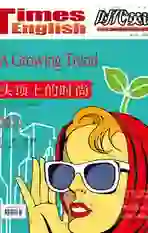头顶上的时尚
2016-05-10
As I walked through Beijings Houhai neighborhood, a flash of green caught my eye. It looked like a fungal infection gone berserk. Sprouts, mushrooms and flowers were emerging from peoples heads, standing straight up like an untamed cowlick.
当我走在北京后海街头,一抹绿色吸引了我的眼球。它看起来就像疯狂的真菌感染。豆芽、蘑菇和花开在人们头顶上,就像额前立起了一绺不听话的乱毛。
It was early August, and I had freshly arrived in China. The craziness of city life, I expected. The weeds flourishing in the hair of passersby? It was not in my imagination.
八月上旬,我来到中国。我期盼的是这儿疯狂的都市生活。行人头上狂长草?这可不在我的想象之中。
Surely this was some kind of environmental protest or an inside joke, I thought. Whatever it was, the trend was fueling a thriving business.
我想这一定是某种环保抗议或者某些圈子里流行的玩笑。不管它是什么,这股风潮可是繁荣了一项产业呢。
Merchants stood on street corners hawking all kinds of plastic fungi and shrubs. Three yuan for one sprout, five for a pair. Customers clipped their purchases onto their heads and walked off, the sprouts flickering.
街角的小贩兜售着各种塑料蘑菇和树枝。豆芽三元一个,五元一对。顾客们把买来的发夹别在头上然后就走了,留下豆芽摇曳的背影。
It would have been easy to brush this off as another bizarre Asian trend, a stereotype common in the West. But this being a hard-hitting, investigative article, I had to find out what was behind the mysterious hairpins. I went to the 798 Art District to research.
它本该像其他奇异的亚洲潮流一样昙花一现,西方人对此早就见怪不怪了。不过鉴于这是一篇有深度的调查性文章,我得下工夫好好研究这个神奇的发夹,于是我去了798艺术区。
Sure enough, there was a bumper crop of sprout-headed tourists, and a shopkeeper told me that it was because of the film Monster Hunt. The movie featured a doughy little monster with a patch of moss atop his head.
不出所料,798有大批“头上长草”的游客,一个店家告诉我是因为电影《捉妖记》。这部电影里有一只像面团一样的小妖精,它的头上有一片苔藓。
An American website reported a different theory: that the hairpins were inspired by a Japanese emoticon. One smiley face has a pair of green leaves growing on its noggin.
美国某网站则给出了不同的解释:这种发夹受一个日本卡通表情启发而来。一个笑脸的脑门上长出了一对绿叶子。
Whatever its origins, the fad was raising some international eyebrows. Major newspapers like The Wall Street Journal and The Daily Telegraph puzzled over the strange display.
且不说它究竟起源何处,这股风潮变得全球瞩目了。诸如《华尔街日报》《每日电讯报》这样的主流媒体都对这种奇怪的现象百思不得其解。
The more attention the sprouts got, the more sales surged. China Daily reported that one Taobao retailer sold 28,850 hairclips in a month. Bean sprouts, dollar weeds and mushrooms were becoming the Beijing equivalent of Mickey Mouse ears at Disney World.
豆芽发夹越受关注,它的销量越好。据《中国日报》报道,某淘宝卖家一个月卖出了28,850个这种发夹。在北京戴豆芽、金钱草和蘑菇就像在迪士尼乐园戴米老鼠耳朵一样。
Theres always a rush to categorize trends, to make them discrete and understandable. Perhaps the hairpins were a symbol of the cute and childlike “meng” culture. Or perhaps they were a nod to surrealism or cartoons or both.
人们总是急于给潮流分门别类,好让它们辨识度高又容易被理解。或许这种发夹就是可爱、童趣的“萌”文化代表,抑或是向超现实主义和卡通致敬。
Who knows? And frankly, who cares? After all, theres a kind of beauty to the mystery. In a city of 20 million people, a few plastic plants made us all stop and take notice of one another. And together, we all wondered what the heck is on your head?
答案不得而知,坦白说,我们也并不想知道。毕竟,美是个玄乎其玄的东西。在一个有2000万人口的城市,一些塑料植物足以让我们驻足一下,关注彼此,然后在心里想:“你头上戴的到底是什么啊?”
